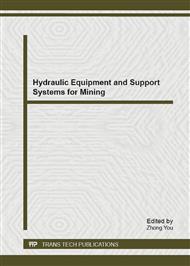p.380
p.384
p.388
p.393
p.399
p.406
p.410
p.415
p.419
Study on Coordinated Control Theory of Shield Thrust Hydraulic System
Abstract:
In order to improve the dynamic coordinated control performance of shield thrust hydraulic cylinder during the shield construction process, we used the shield electro-hydraulic control synthetic experimental platform as research object. The simulation models of thrust system and external loading were built in AMESim. The result of PID closed-loop simulation indicated that thrust system can enable the compound control of thrust pressure and velocity by using the compound control technique of pressure and flow. In view of the complex and varied external load condition of shield thrust system, we simulated the fuzzy and fuzzy-PID control strategy of thrust system in passive automatic adjustment mode, based on the Joint Modeling and Simulation Environment (JMASE) of AMESim and Matlab/Simulink. The multi-external loads of thrust system mainly contained unequal-fixed load, equal-variable load and unequal-variable load. Finally, a coordinated control theory of shield thrust system was put forward. Such theory could provide some theoretical guidance for the design of shield machine and control of shield construction.
Info:
Periodical:
Pages:
399-405
Citation:
Online since:
December 2012
Authors:
Keywords:
Price:
Сopyright:
© 2013 Trans Tech Publications Ltd. All Rights Reserved
Share:
Citation:


